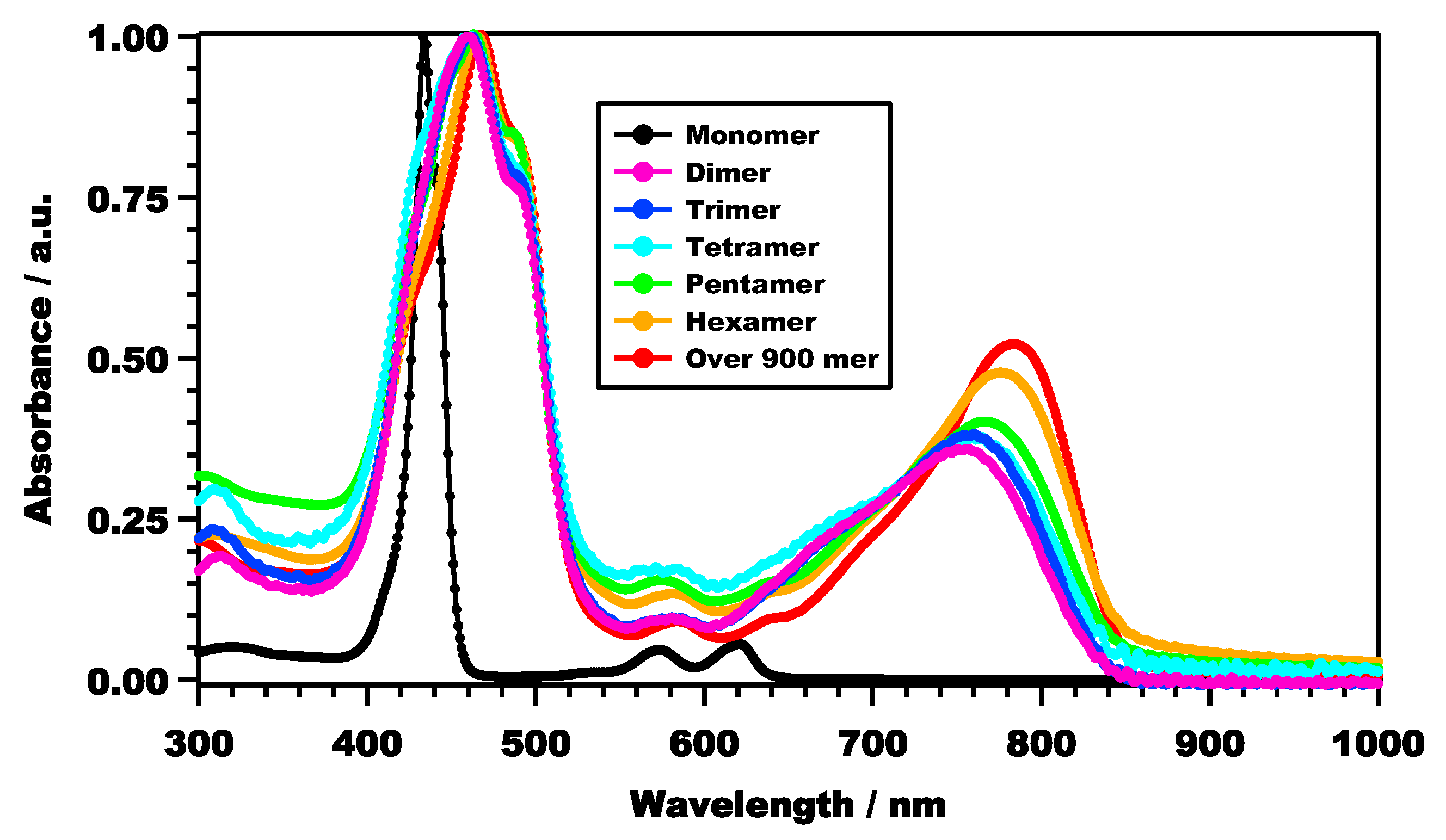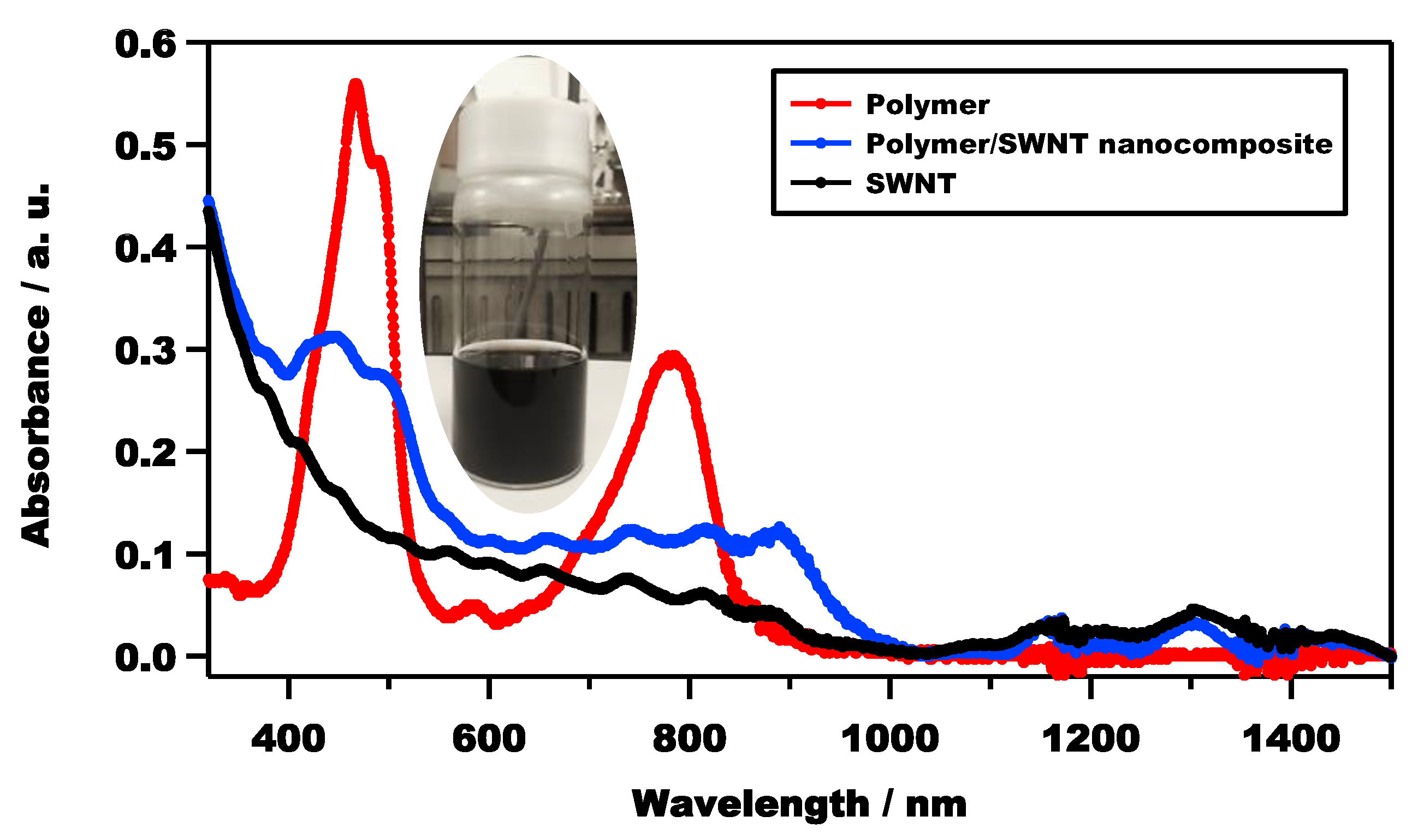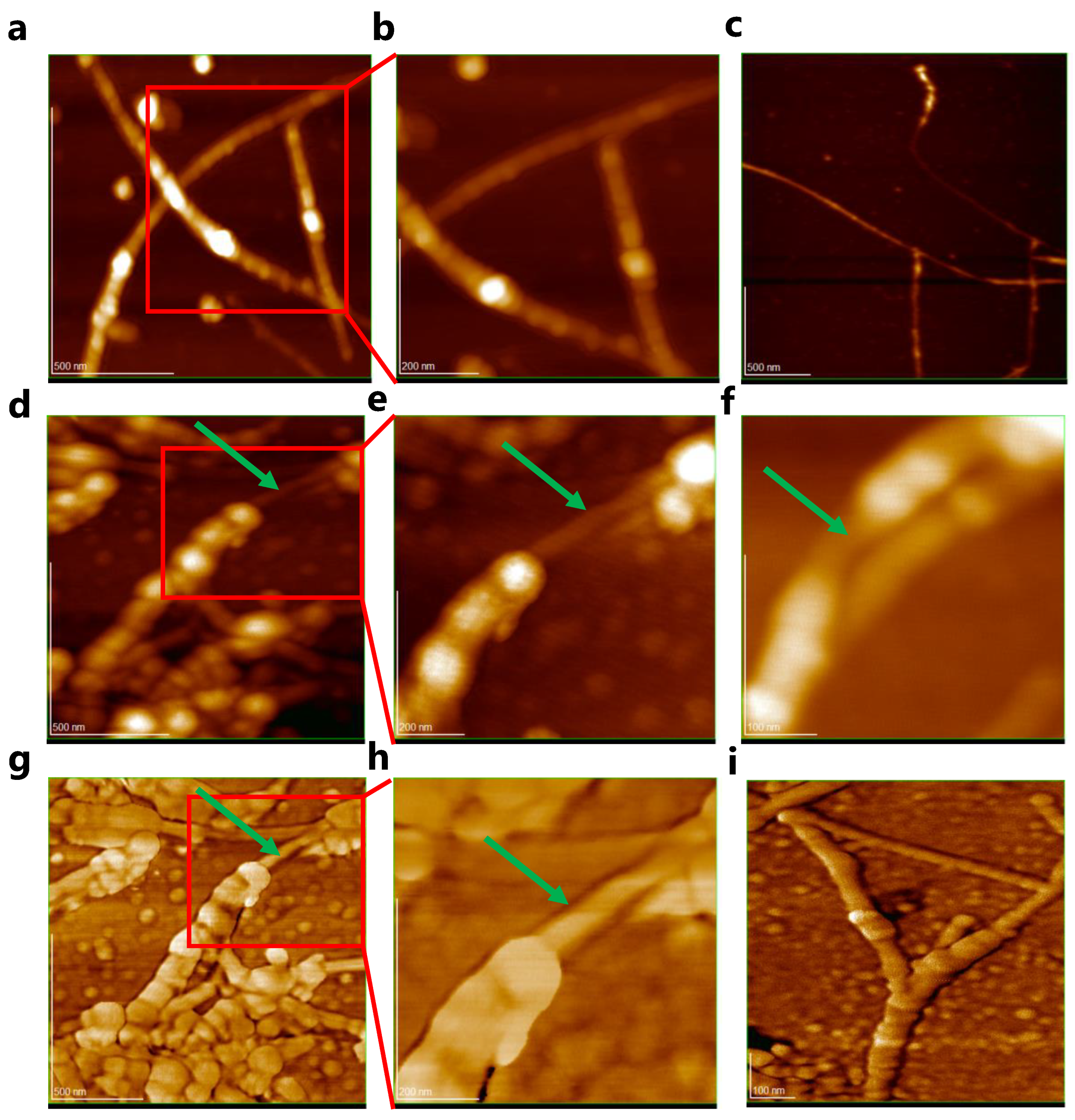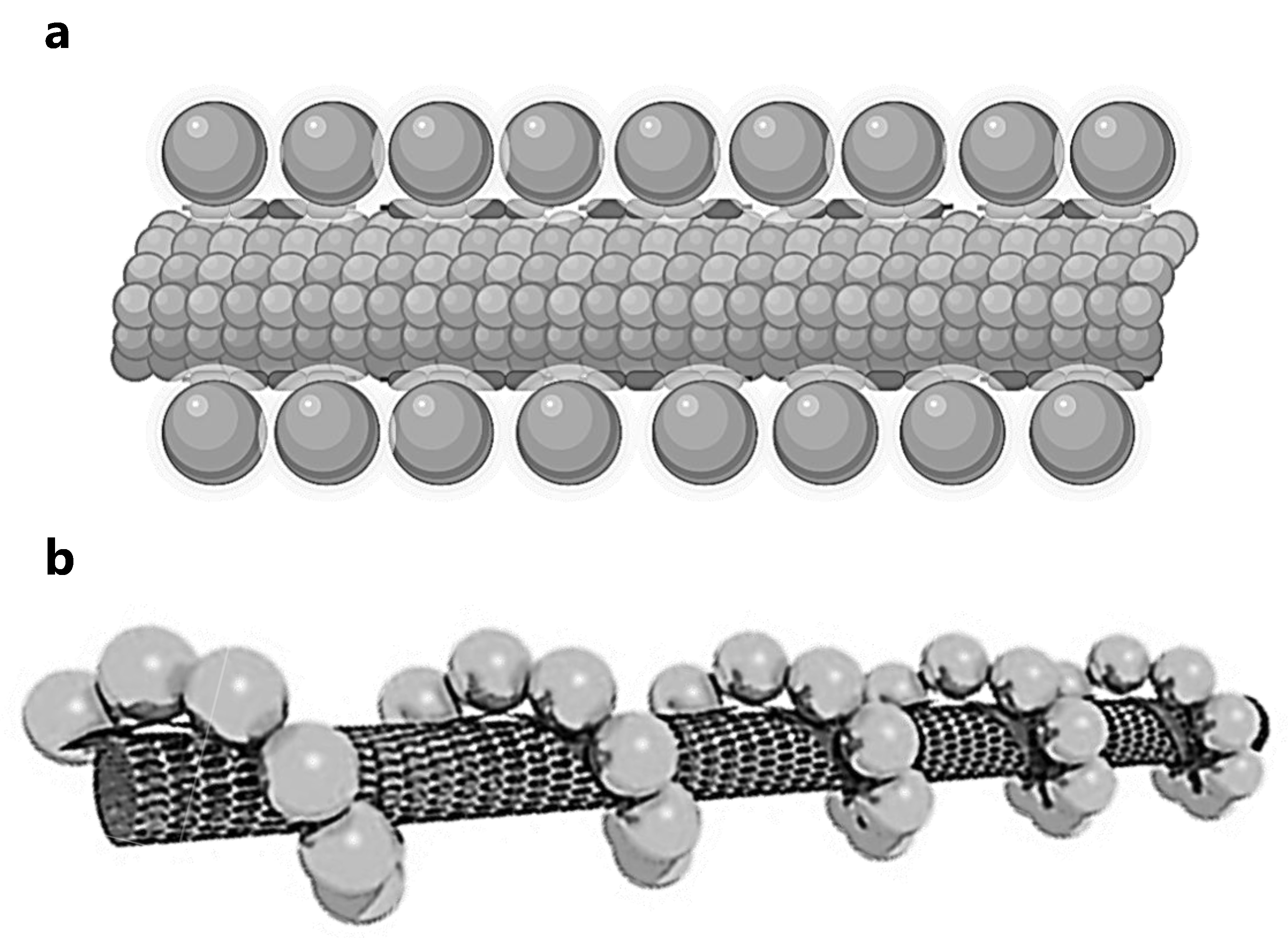Identification of Supramolecular Structures of Porphyrin Polymer on Single-Walled Carbon Nanotube Surface Using Microscopic Imaging Techniques
Abstract
1. Introduction
2. Experimental Section
2.1. Synthesis of the Target Molecules
2.2. Polymer Purification
2.3. Purification of Raw-HiPCO SWNT
2.4. Fabrication of Porphyrin Polymer/SWNT Nanocomposite
2.5. Synthesis of t-Dodecanethiol-Pyridine Ethanethiol Capped AuNPs
2.6. Fabrication of Porphyrin Polymer/AuNPs/SWNT Nanohybrid
3. Results and Discussion
3.1. Synthesis of the Target Molecules
3.2. Supramolecular Structure of Porphyrin Polymer on HOPG Surface Characterized by AFM
3.3. Supramolecular Structure of Porphyrin Polymer on SWNT Surface
3.4. Supramolecular Structure of Porphyrin Polymer Marked with AuNPs on SWNT Surface
4. Conclusions
5. Highlights
- The supramolecular structure of poly-[5,15-bis-(3,5-isopentoxyphenyl)-10,20-bis ethynylporphyrinato]-zinc (II) on the SWNT surface was identified using mainly AFM and HR-TEM microscopic imaging techniques;
- Around >900 mer of porphyrin polymer was synthesized using Glaser-Hay coupling (i.e., copper catalyzed oxidative coupling) of diethynylporphyrin with Cu(OAc)2 in pyridine under overnight heating at 60 °C;
- The as-prepared porphyrin was then non-covalently adsorbed on SWNT surface via π-π stacking as well as van der Waal interactions;
- Afterward, the resultant porphyrin/SWNT nanocomposite was then anchored with gold nanoparticles (AuNPs), which were used as a marker, via coordination bonding to produce a porphyrin polymer/AuNPs/SWNT hybrid;
- The self-assembly arrays of porphyrin polymers (marked with AuNPs) moieties prefer to form a coplanar, well-ordered, regular, repeated array (rather than wrapping) between neighboring molecules along the polymer chain on the tube surface;
- This will help with further understanding, designing, and fabricating novel supramolecular architectonics of porphyrin/SWNT-based devices.
Supplementary Materials
Author Contributions
Funding
Institutional Review Board Statement
Informed Consent Statement
Data Availability Statement
Conflicts of Interest
References
- Milgrom, L.R. The Colours of Life: An Introduction to the Chemistry of Porphyrins and Related Compounds; Oxford University Press: Oxford, UK, 1997. [Google Scholar]
- RBonnett Dolphin, D. The Porphyrins; Academic Press: New York, NY, USA, 1978; Volume I, pp. 1–27. [Google Scholar]
- Tanaka, T.; Osuka, A. Conjugated porphyrin arrays: Synthesis, properties and applications for functional materials. Chem. Soc. Rev. 2015, 44, 943–969. [Google Scholar] [CrossRef]
- Duong, B.; Arechabaleta, R.; Tao, N. In situ AFM/STM characterization of porphyrin electrode films for electrochemical detection of neurotransmitters. J. Electroanal. Chem. 1998, 447, 63–69. [Google Scholar] [CrossRef]
- Harima, Y.; Okazaki, H.; Kunugi, Y.; Yamashita, K.; Ishii, H.; Seki, K. Formation of Schottky barriers at interfaces between metals and molecular semiconductors of p-and n-type conductances. Appl. Phys. Lett. 1996, 69, 1059–1061. [Google Scholar] [CrossRef]
- Liu, C.-y.; Pan, H.-I.; Fox, M.A.; Bard, A.J. Films of the Photoconductor ZnODEP. Sens. Actuators A 1990, 21, 193. [Google Scholar]
- Malinski, T.; Taha, Z. Nitric oxide release from a single cell measured in situ by a porphyrinic-based microsensor. Nature 1992, 358, 676–678. [Google Scholar] [CrossRef] [PubMed]
- Maree, C.; Roosendaal, S.; Savenije, T.; Schropp, R.; Schaafsma, T.; Habraken, F. Photovoltaic effects in porphyrin polymer films and heterojunctions. J. Appl. Phys. 1996, 80, 3381–3389. [Google Scholar] [CrossRef]
- Reimers, J.; Crossley, M.; Hush, N. Molecular electronic properties of fused rigid porphyrin-oligomer molecular wires. Nanotechnology 1996, 7, 424. [Google Scholar] [CrossRef]
- Abd El-Mageed, A.I.; Ogawa, T. Single-walled carbon nanotube absolute-handedness chirality assignment confirmation using metalized porphyrin’s supramolecular structures via STM imaging technique. Chirality 2020, 32, 345–352. [Google Scholar] [CrossRef]
- Tanaka, D.; Inose, T.; Shimono, S.; Tanaka, H.; Tamaki, T.; Abd El-Mageed, A.I.; Dyab, A.K.; Ishikawa, N.; Ogawa, T. Surface Self-Assembly of Trans-Substituted Porphyrin Double-Decker Complexes Exhibiting Slow Magnetic Relaxation. E-J. Surf. Sci. Nanotechnol. 2014, 12, 124–128. [Google Scholar] [CrossRef]
- El-Mageed, A.; Ahmed, I.; Ogawa, T. Supramolecular Structures of Organic Molecules-Single Walled Carbon Nanotube Nanocomposites. In Advances in Nanocomposite Materials for Environmental and Energy Harvesting Applications; Springer: New York, NY, USA, 2022; pp. 921–940. [Google Scholar]
- Bedi, A.; Zade, S.S. Metal-Containing Conjugated Polymers: Photovoltaic and Transistor Properties. In Functional Polymers; Apple Academic Press: Palm Bay, FL, USA, 2017; pp. 323–356. [Google Scholar]
- Maity, S.; Bedi, A.; Patil, S. Side-chain induced chirality in diketopyrrolopyrrole based polymers. J. Polym. Sci. 2021, 59, 3181–3188. [Google Scholar] [CrossRef]
- Dresselhaus, M.S.; Dresselhaus, G.; Jorio, A. Unusual Properties and Structure of Carbon Nanotubes. Annu. Rev. Mater. Res. 2004, 34, 247–278. [Google Scholar] [CrossRef]
- Avouris, P. Molecular electronics with carbon nanotubes. Acc. Chem. Res. 2002, 35, 1026–1034. [Google Scholar] [CrossRef] [PubMed]
- Urdampilleta, M.; Klyatskaya, S.; Cleuziou, J.-P.; Ruben, M.; Wernsdorfer, W. Supramolecular spin valves. Nat. Mater. 2011, 10, 502. [Google Scholar] [CrossRef] [PubMed]
- Tans, S.J.; Verschueren, A.R.; Dekker, C. Room-temperature transistor based on a single carbon nanotube. Nature 1998, 393, 4952. [Google Scholar] [CrossRef]
- Zhang, T.; Nix, M.B.; Yoo, B.Y.; Deshusses, M.A.; Myung, N.V. Electrochemically functionalized single-walled carbon nanotube gas sensor. Electroynalysis 2006, 18, 1153–1158. [Google Scholar] [CrossRef]
- Kong, J.; Franklin, N.R.; Zhou, C.; Chapline, M.G.; Peng, S.; Cho, K.; Dai, H. Nanotube molecular wires as chemical sensors. Science 2000, 287, 622–625. [Google Scholar] [CrossRef] [PubMed]
- Li, J.; Lu, Y.; Ye, Q.; Cinke, M.; Han, J.; Meyyappan, M. Carbon nanotube sensors for gas and organic vapor detection. Nano Lett. 2003, 3, 929–933. [Google Scholar] [CrossRef]
- Gao, C.; Guo, Z.; Liu, J.-H.; Huang, X.-J. The new age of carbon nanotubes: An updated review of functionalized carbon nanotubes in electrochemical sensors. Nanoscale 2012, 4, 1948–1963. [Google Scholar] [CrossRef]
- Liu, Z.; Tabakman, S.; Welsher, K.; Dai, H. Carbon nanotubes in biology and medicine: In vitro and in vivo detection, imaging and drug delivery. Nano Res. 2009, 2, 85–120. [Google Scholar] [CrossRef]
- Akasaka, T.; Watari, F.; Sato, Y.; Tohji, K. Apatite formation on carbon nanotubes. Mater. Sci. Eng. C 2006, 26, 675–678. [Google Scholar] [CrossRef]
- Serp, P.; Corrias, M.; Kalck, P. Carbon nanotubes and nanofibers in catalysis. Appl. Catal. A 2003, 253, 337–358. [Google Scholar] [CrossRef]
- Planeix, J.; Coustel, N.; Coq, B.; Brotons, V.; Kumbhar, P.; Dutartre, R.; Geneste, P.; Bernier, P.; Ajayan, P. Application of carbon nanotubes as supports in heterogeneous catalysis. J. Am. Chem. Soc. 1994, 116, 7935–7936. [Google Scholar] [CrossRef]
- Baraton, M.-I. Synthesis, Functionalization and Surface Treatment of Nanoparticles; Amer Scientific Pub: Valencia, CA, USA, 2003; Volume 9. [Google Scholar]
- Schmid, G. Nanoparticles: From Theory to Application; John Wiley & Sons: Hoboken, NJ, USA, 2011. [Google Scholar]
- El-Mageed, A.I.A.; Ogawa, T. Metal Ion Effect on the Supramolecular Structures of Metalloporphyrins on Single-Walled Carbon Nanotube Surface. Appl. Surf. Sci. 2018, 462, 904–912. [Google Scholar] [CrossRef]
- Abd El-Mageed, A.I.; Ogawa, T. Supramolecular structures of terbium (iii) porphyrin double-decker complexes on a single-walled carbon nanotube surface. RSC Adv. 2019, 9, 28135–28145. [Google Scholar] [CrossRef] [PubMed]
- Abd El-Mageed, A.I.; Handayani, M.; Chen, Z.; Inose, T.; Ogawa, T. Assignment of the Absolute-Handedness Chirality of Single-Walled Carbon Nanotubes by Using Organic Molecule Supramolecular Structures. Chem. Eur. J. 2019, 25, 1941–1948. [Google Scholar] [CrossRef] [PubMed]
- Ozawa, H.; Yi, X.; Fujigaya, T.; Niidome, Y.; Asano, T.; Nakashima, N. Supramolecular hybrid of gold nanoparticles and semiconducting single-walled carbon nanotubes wrapped by a porphyrin–fluorene copolymer. J. Am. Chem. Soc. 2011, 133, 14771–14777. [Google Scholar] [CrossRef] [PubMed]
- Kawao, M.; Ozawa, H.; Tanaka, H.; Ogawa, T. Synthesis and self-assembly of novel porphyrin molecular wires. Thin Solid Films 2006, 499, 23–28. [Google Scholar] [CrossRef]
- Ozawa, H.; Kawao, M.; Uno, S.; Nakazato, K.; Tanaka, H.; Ogawa, T. A photo-responsive molecular wire composed of a porphyrin polymer and a fullerene derivative. J. Mater. Chem. 2009, 19, 8307–8313. [Google Scholar] [CrossRef]
- Ozawa, H.; Kawao, M.; Tanaka, H.; Ogawa, T. Preparation of long conjugated porphyrin polymers with gold nanoparticles at both ends as electronic and/or photonic molecular wires. Chem. Lett. 2009, 38, 542–543. [Google Scholar] [CrossRef]
- Ozawa, H.; Kawao, M.; Tanaka, H.; Ogawa, T. Synthesis of dendron-protected porphyrin wires and preparation of a one-dimensional assembly of gold nanoparticles chemically linked to the π-conjugated wires. Langmuir 2007, 23, 6365–6371. [Google Scholar] [CrossRef]
- Tanaka, H.; Yajima, T.; Kawao, M.; Ogawa, T. Electronic properties of a single-walled carbon nanotube/150mer-porphyrin system measured by point-contact current imaging atomic force microscopy. J. Nanosci. Nanotechnol. 2006, 6, 1644–1648. [Google Scholar] [CrossRef] [PubMed]
- Sprafke, J.K.; Stranks, S.D.; Warner, J.H.; Nicholas, R.J.; Anderson, H.L. Noncovalent binding of carbon nanotubes by porphyrin oligomers. Angew. Chem. 2011, 123, 2361–2364. [Google Scholar] [CrossRef]
- Cheng, F.; Zhang, S.; Adronov, A.; Echegoyen, L.; Diederich, F. Triply Fused ZnII–Porphyrin Oligomers: Synthesis, Properties, and Supramolecular Interactions with Single-Walled Carbon Nanotubes (SWNTs). Chem. Eur. J. 2006, 12, 6062–6070. [Google Scholar] [CrossRef] [PubMed]
- Cheng, F.; Adronov, A. Noncovalent functionalization and solubilization of carbon nanotubes by using a conjugated Zn–porphyrin polymer. Chem. Eur. J. 2006, 12, 5053–5059. [Google Scholar] [CrossRef]
- Brust, M.; Walker, M.; Bethell, D.; Schiffrin, D.J.; Whyman, R. Synthesis of thiol-derivatised gold nanoparticles in a two-phase liquid–liquid system. J. Chem. Soc. Chem. Comm. 1994, 7, 801–802. [Google Scholar] [CrossRef]
- Duff, D.G.; Baiker, A.; Edwards, P.P. A new hydrosol of gold clusters. J. Chem. Soc. Chem. Comm. 1993, 1, 96–98. [Google Scholar] [CrossRef]









Disclaimer/Publisher’s Note: The statements, opinions and data contained in all publications are solely those of the individual author(s) and contributor(s) and not of MDPI and/or the editor(s). MDPI and/or the editor(s) disclaim responsibility for any injury to people or property resulting from any ideas, methods, instructions or products referred to in the content. |
© 2023 by the authors. Licensee MDPI, Basel, Switzerland. This article is an open access article distributed under the terms and conditions of the Creative Commons Attribution (CC BY) license (https://creativecommons.org/licenses/by/4.0/).
Share and Cite
Abd El-Mageed, A.I.A.; Ogawa, T. Identification of Supramolecular Structures of Porphyrin Polymer on Single-Walled Carbon Nanotube Surface Using Microscopic Imaging Techniques. Polymers 2023, 15, 1439. https://doi.org/10.3390/polym15061439
Abd El-Mageed AIA, Ogawa T. Identification of Supramolecular Structures of Porphyrin Polymer on Single-Walled Carbon Nanotube Surface Using Microscopic Imaging Techniques. Polymers. 2023; 15(6):1439. https://doi.org/10.3390/polym15061439
Chicago/Turabian StyleAbd El-Mageed, Ahmed I. A., and Takuji Ogawa. 2023. "Identification of Supramolecular Structures of Porphyrin Polymer on Single-Walled Carbon Nanotube Surface Using Microscopic Imaging Techniques" Polymers 15, no. 6: 1439. https://doi.org/10.3390/polym15061439
APA StyleAbd El-Mageed, A. I. A., & Ogawa, T. (2023). Identification of Supramolecular Structures of Porphyrin Polymer on Single-Walled Carbon Nanotube Surface Using Microscopic Imaging Techniques. Polymers, 15(6), 1439. https://doi.org/10.3390/polym15061439







